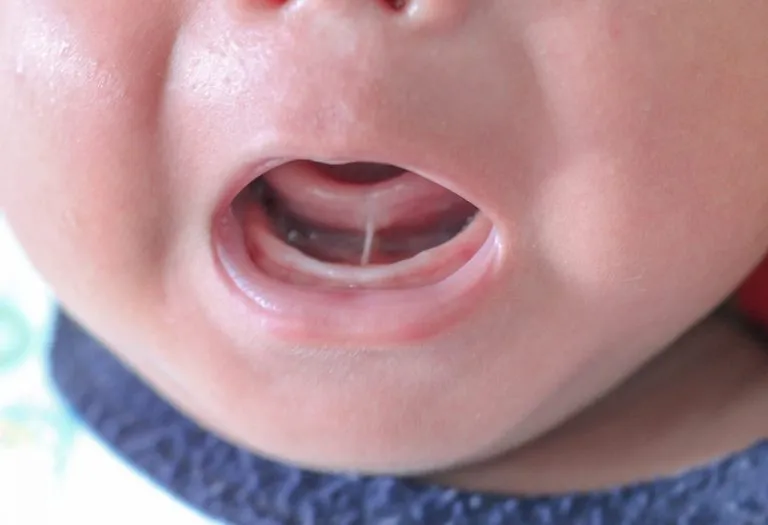Tongue Tie (Ankyloglossia) – Types, Causes, Symptoms & Treatment

- What Is Tongue-Tie (Ankyloglossia)?
- Types of Tongue-Tie
- Symptoms of Tongue-Tie in Babies
- Causes of Tongue Tie in Infants
- Complications Due to Tongue-Tie
- Diagnosis of Tongue-Tie
- Treatment of Tongue-Tie
- Tongue Tie Exercises for Newborn
- Things to Keep in Mind While Doing These Exercises
- Tongue-Tie Surgery Procedure
- FAQs
Not many people are aware of the medical condition known as tongue-tie, or ankyloglossia. Instead, they might think of a person being unable to speak when flustered. However, tongue-tie is a real medical condition that affects many newborns, often referred to as tied tongue in newborns. This condition occurs when the thin piece of tissue under the baby’s tongue (the lingual frenulum) is shorter than usual, restricting movement. If left untreated, it can lead to difficulties in breastfeeding, speech delays, and other oral health issues. In this article, we shall discuss the condition in detail, including its symptoms, potential complications, and treatment options. Understanding tongue-tie can help parents seek early intervention for their child. Read on to know more about this often-overlooked condition.
What Is Tongue-Tie (Ankyloglossia)?
Tongue-tie or ankyloglossia is a congenital condition. It affects the range and function of the tongue. Babies with this condition have a shorter, thicker or tight lingual frenulum which is a tissue that connects the underside of the tongue to the floor of the mouth. The length/thickness of the lingual frenulum in babies with tongue-tie restricts the movement of their tongues. If the condition is left untreated, it affects breastfeeding and later on the baby’s ability to eat, speak, and swallow (1).
Tongue-tie is classified into different categories depending on the length and the positioning of the lingual frenulum. Let’s find out what they are.
Types of Tongue-Tie
Tongue-ties are classified according to the location the tongue is attached to the floor of the mouth (2).
- Class One: This is the most common type of tongue-tie, wherein the tie is at the tip of the tongue.
- Class Two: The tie is farther back towards the middle of the tongue.
- Class Three: The tie is located at the base of the tongue.
- Class Four: Also known as Posterior Tongue-Tie (PTT), the tie is underneath the mucous membrane. Usually, this condition is mistaken for a short tongue.
Several times, it is difficult to know if the baby is affected by the condition. These symptoms should help you figure it out and get necessary medical attention if required.
Symptoms of Tongue-Tie in Babies
Here are a few symptoms of tongue-tie that you can look out for in your baby (3):
- Your baby might have difficulty lifting her tongue and touching it to the roof of her mouth or moving it from one side to the other.
- Your baby might not be able to stick her tongue out.
- When the tongue is stuck out, it might appear heart-shaped or even notched.
You may also notice some symptoms while breastfeeding your baby. These could be:
- Inability to stay attached to the nipple for the full feed.
- Feed for a long time with short breaks.
- Baby makes a clicking sound while breastfeeding.
- Not gaining the right amount of weight.
- Baby gets irritable during the feed.

These signs of tongue tie in newborns occur because your baby cannot open her mouth wide enough to latch onto the nipple properly. However, you must keep in mind that the baby wouldn’t be able to latch on because of other issues like incorrect support, inappropriate positioning of the baby, etc. You must, therefore, talk to a paediatrician about your concerns and seek medical attention.
Now you know what tongue-tie is and what its symptoms are. But, what causes the condition? Let’s find out.
Causes of Tongue Tie in Infants
Tongue-tie is a congenital condition, which means that the baby is born with the condition. It is not something that develops after birth. In most cases, the lingual frenulum will separate from the tongue before birth allowing for a free range of motion. In babies who suffer from tongue-tie, however, the frenulum remains attached to the tongue even after birth. No one seems to know exactly why this happens. A few theories suggest that tongue-tie could have some genetic factors responsible for its occurrence (4). Some people believed that tongue-tie occurred only in dysmorphic children and rarely in normal children. Several babies are affected by this condition, who further experience health complications, which we shall talk about below.
Complications Due to Tongue-Tie
A tongue-tie can severely affect all aspects of your baby’s life that are directly related to her mouth. The tongue tie will affect oral development and the way your baby speaks, eats, and swallows too.

Some of the complications that can arise from tongue-tie are (5):
1. Breastfeeding Issues
Usually, babies with a normal lingual frenulum use their tongues to cover their lower gums while feeding. But, babies affected with the condition will most likely chew on the nipple rather than suck. Apart from causing breast pain, it could also result in inadequate feeding. This could, in turn, cause malnourishment.
2. Speech Issues
Tongue-tie hinders speech and the ability to make certain sounds like ‘t’, ‘d’, ‘z’, ‘l’, and ‘th’. Your child will find it particularly hard to make the rolling ‘r’ sound.
3. Inadequate Oral hygiene
A tongue-tie makes it hard to brush away the food particles stuck in the mouth. It could, therefore, lead to tooth decay and swelling of the gums. A tongue-tie could also cause a gap in the bottom front teeth.
4. Affects Other Activities
A tongue-tie will affect several other activities that involve the mouth. Children with this condition will find it a lot harder to playing wind instruments, lick their favourite ice cream or their lips too.
Diagnosis of Tongue-Tie
Your child’s paediatrician can diagnose the condition through a physical examination. He/she will carry out a series of tests based on the appearance and mobility of the child’s tongue and confirm or categorise the condition.
Under no circumstances must you make the diagnosis yourself or allow non-professionals to do so. Voice your concerns with your child’s paediatrician and clarify all doubts to put your fears to rest.
Treatment of Tongue-Tie
The treatment for ankyloglossia or tongue-tie is considered controversial as some experts say that it is an unnecessary procedure, while some suggest that the condition should be corrected at the earliest. One can undergo surgery to correct tongue-tie, and it can be done at any stage, depending on how much the condition is affecting their life. Also, bear in mind that at times, the condition does not cause any complications or it is resolved on its own in the first few weeks after childbirth (6).
For those who are considering surgery, some information on it can help them make an informed decision. Read to know more.
Tongue Tie Exercises for Newborn
Gentle exercises can help improve tongue mobility and strengthen muscles. Below are some effective tongue-tie exercises for newborns, which should be performed carefully and ideally under professional guidance.
1. Finger Sweep Exercise
Gently slide a clean finger under the baby’s tongue and sweep from side to side. This helps stretch the tight frenulum and encourages better tongue movement.
2. Tongue Lifting Exercise
Place a clean fingertip under the baby’s tongue and apply light upward pressure. Hold for a few seconds to help stretch the frenulum and improve elevation.
3. Side-to-Side Stretch
With a gloved finger, gently push the baby’s tongue to one side and hold for a few seconds, then repeat on the other side. This enhances lateral mobility.
4. Thumb Press Technique
Using your thumb, press downward on the baby’s lower gum while encouraging them to lift their tongue. This strengthens the tongue’s upward motion.
5. Suck Training Exercise
Encourage the baby to suck on your clean finger, ensuring they use their tongue correctly. This helps improve sucking coordination for better breastfeeding.
6. Smile Stretch
Gently pull the corners of the baby’s mouth outward into a “smile” while they try to lift their tongue. This promotes tongue retraction and flexibility.
Things to Keep in Mind While Doing These Exercises
Performing tongue-tie exercises for newborns requires patience, gentleness, and proper technique to ensure safety and effectiveness. Here are key points to remember:
- A newborn’s mouth is extremely sensitive, so all movements should be soft and controlled. Avoid forceful stretching, which can cause pain or injury.
- Always wash your hands thoroughly and use medical gloves if possible to prevent infections. Ensure your fingers are clean before performing any oral exercises.
- Consult a pediatrician, lactation consultant, or speech therapist before starting exercises to ensure they are appropriate for your baby’s specific condition.
- If your baby becomes fussy, cries excessively, or resists the exercises, stop immediately. Forcing movements can create negative associations with feeding.
- Short, frequent sessions (2-3 times a day) are more effective than long, infrequent ones. However, avoid overstimulating the baby.
Tongue-Tie Surgery Procedure
Surgery might be recommended when tongue-tie affects most activities of your baby’s mouth like speech, eating, swallowing, etc. There are two types of surgeries that can help treat the condition – Frenuloplasty and Frenotomy.
1. Frenotomy
Also known as Tongue-Tie Division, this is the simpler of the two procedures and can be carried out in the doctor’s office with or without anaesthesia. After examining the frenulum, the doctor will use a pair of sterile scissors to snip the frenulum. Since there are very few nerve endings and blood vessels in that area, there will be little to no pain and bleeding.
After the procedure, your baby can be breastfed immediately. There are very few complications that can arise from this procedure, and it is extremely safe.
2. Frenuloplasty
A frenuloplasty is a more extensive procedure that is carried out under general anaesthesia. It is done in cases where the frenulum is thick or if additional repair is required. After the frenulum is cut, sutures are used to close the wound. The sutures are absorbed on their own as the tongue heals.
FAQs
1. Can tongue-tie grow back after a frenotomy?
While rare, some babies may experience reattachment of the frenulum after a frenotomy (tongue-tie release). This can happen if post-procedure stretching exercises aren’t performed consistently. If restricted movement returns, a follow-up evaluation may be needed.
2. Can tongue-tie cause digestive issues like reflux or colic?
Indirectly, yes. Poor latch and inefficient sucking due to tongue-tie can lead to excessive air intake during feeds, increasing gas, reflux, or colic-like symptoms. Correcting the tie may improve feeding and reduce these issues.
A tongue-tie occurs in up to 2-4% of all newborn babies. While many cases do not affect permanently, other cases need to be taken care of surgically. While the condition is not life-threatening, it can cause issues like poor oral health and a general inability to enjoy life. Talk to your baby’s medical practitioner to know about the options you could use to treat tongue-tie in your baby. At the end of the day, the quality of your baby’s life is what matters the most.
References/Resources:
1. National Library of Medicine – Ankyloglossia (Tongue-Tie)
2. Johns Hopkins Medicine – Tongue-Tie (Ankyloglossia)
3. Mayo Clinic – Tongue-tie (ankyloglossia)
4. Nemours Kids Health – Tongue Tie (Ankyloglossia)
5. Harvard Health Publishing – What is a tongue-tie? What parents need to know
Also Read:
How to Clean Baby’s Tongue
Babies Chewing their Tongue
Why Do Bbabies Stick Their Tongue Out?
Extrusion Reflex (Tongue Thrust Reflex) in Babies
Was This Article Helpful?
Parenting is a huge responsibility, for you as a caregiver, but also for us as a parenting content platform. We understand that and take our responsibility of creating credible content seriously. FirstCry Parenting articles are written and published only after extensive research using factually sound references to deliver quality content that is accurate, validated by experts, and completely reliable. To understand how we go about creating content that is credible, read our editorial policy here.
























